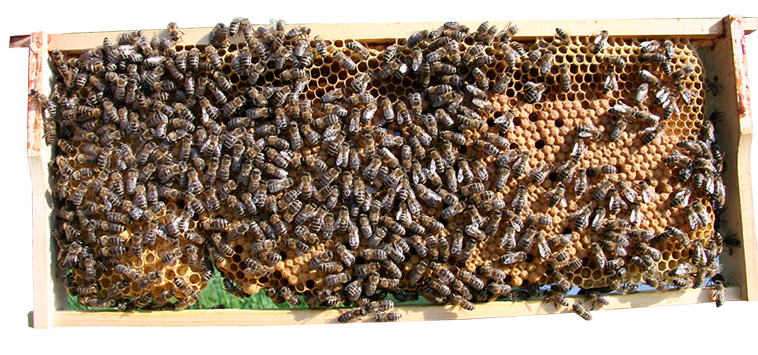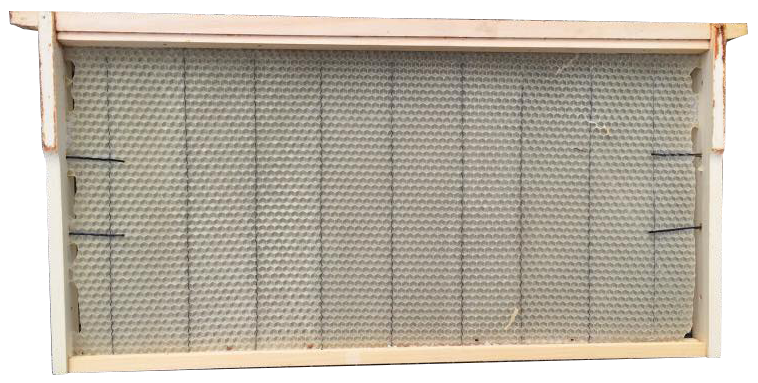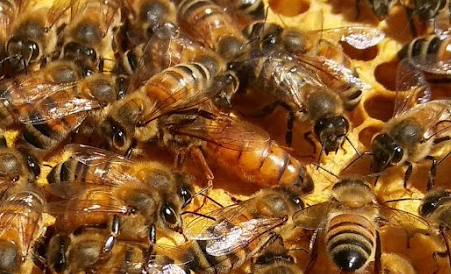So you are at the point in your planning for bees where you are stuck with some ideological decisions. This article is intended to help you with the decision of whether you should use foundation in your frames or not, and if you choose to use foundation, which one? There are pros and cons to every decision in life and this is no exception. Here is the truth of it.


HISTORY
In 1851 a man named Lorenzo Lorraine Langstroth revolutionized beekeeping with the invention of the removable frame hive, now known as the Langstroth hive. He used the invention of the Leaf Hive, a system where the frames were removed all in one piece and examined like pages in a book, and furthered the technology by making each individual frame a separate and independent piece. In his seminal work, Langstroth on the Hive and the Honey-Bee, he cleverly summarized the necessity that was the mother of his invention, “…with proper precautions, the combs might be removed without enraging the bees…” (Langstroth on the Hive and The Honey-Bee, p. 15, 1860)


Shortly thereafter, in 1857, a German named Johannes Mehring added to the removable frame hive by inventing a press that allowed the beekeeper to form wax sheets of starter comb that could be placed inside the frame. This encouraged the bees to form their comb in orderly lines and strengthened the comb by connecting it to all four corners of the frame. The benefits to these wax sheets were easily recognizable and this quickly became the standard method of keeping bees in Europe and North America.
Since 1857 some key changes have been made to foundation, the cell sizes are larger, the construction is usually strengthened with wire, wax paper, plastic or rivets and the most widely available sources for foundation are waxed from large vats of collected beeswax from thousands of hives across a large geographic area. The reasons for these alterations are logical and based in good intentions, the outcome, however, is ambiguous and for this reason the modern beekeeping community is divided.
Foundationless Beekeeping: The Pros and Cons


First of all let me clarify by saying foundationless beekeeping and small cell beekeeping are not automatically the same thing, for the most part this section of the article will talk about foundationless beekeeping and I will specify when referring to small cell beekeeping.
Many modern beekeepers try to keep their bees with a naturalist mindset with the intentions of helping out the local ecology, the environment, their garden and the overall plight of the honeybee. The idea of using mass produced wax sheets made from unknown sources of beeswax doesn’t fall in line with the naturalist ideology and for good reason. Every study I have read about the presence of chemicals in beeswax has said, unequivocally, that pesticides, fungicides, agaricides (including the ones used to fight varroa, like fluvalinate) and herbicides can be stored in wax and that the levels of these chemicals increase over time as more bees come back from foraging with traces on themselves or in the nectar or pollen that they brought back. When you take the wax from numerous different commercial beekeepers who all treat their hives with different chemicals and transport their bees from commercial farm to commercial farm, combine it in a wax-melter and use it to coat thousands of frames, the chemicals are concentrated and ubiquitous.
So, foundationless beekeeping replaces these sheets of tainted convenience with… nothing. Some in the pro-foundation camp claim that starting your bees off with nothing requires them to do more work to get established but anyone who has seen a healthy colony of bees build up during a nectar flow will know that even if the amount of energy is marginally more, the bees don’t mind and you won’t notice any lag. Bees in the right conditions will draw out as much wax as they can, anywhere they can, as fast as they can.
In addition to the lack of inherent chemicals in the hive, a benefit to foundationless beekeeping is the freedom it allows when dealing with queen cells and drone brood. Having a paper or plastic sheet running through the middle of your combs prevents the beekeeper from easily removing portions without removing the entire frame. The instance where this can be a hindrance is during swarm season, when you open up your hive and find numerous ripe swarm cells hanging from the bottoms of your frames. You want to split them up, utilize these awesome cells, but find removing the cells from the foundation without damaging them a difficult task. The foundationless folks read this with a knowing smile on their face as they don’t see this as a problem at all. A sharp knife and steady hands can carve around those cells easily, giving you the opportunity to expand your apiary quickly and easily. This ability to carve comb out of a frame also allows any portion of capped drone brood to be removed, allowing the beekeeper to mitigate the mite load without including any chemicals or purchasing any specialized drone brood frames.
The cons for foundationless beekeeping are easy to see but for some they seem a small price to pay for the benefits. The ability to cut through the comb is based in the fact that there is no added structural capability, this can be a problem when manipulating the frame for an inspection, or when a honey frame is placed in a centrifugal extractor because of the malleable nature of beeswax. Some foundationless beekeepers claim to have the ability to use honey frames in an extractor but they require special care and the risk of blowing the comb out of the frame is much higher than a frame with foundation.
Another area of special care required for the foundationless beekeeper is the cross comb situation. If left totally unhindered, bees often draw comb at angles that eliminate the versatile nature of the removable frame. If not corrected quickly this problem can become a real mess and for the new beekeeper the issue can seem overwhelming.
In the foundationless beekeeping camp there is a subset of beekeepers who practice small cell beekeeping. Their idea is that mites require open brood to multiply and the amount of time the proto-bee requires to develop is directly proportional to the amount of mites that emerge from the cell with the hatching bee. Small cell, or, natural cell worker bees normally hatch after 20 days as opposed to 21 for the larger cell size that is imprinted on foundation sheets. This idea is great in theory but the actual benefit has not been substantiated in any test I have seen.
Wax Foundation: The Pros and Cons


This section will cover the pros and cons of the use of wax foundation in wooden frames. There are numerous different versions of wax foundation, some with wax paper in the middle for structure and some just wax supported with wires or rivets.
The main benefit you will see in comparison to foundationless beekeeping is the ease of use for the beekeeper. Whether you are talking about manipulation of frames for inspection, use in extractors or the incentive for the bees to draw out straight, manageable combs, the day to day operations for the beekeeper are easier with the added stability. As a beginner getting into a hive for inspection you want to pull frames out to witness the marvel that is the inside of an active, healthy colony of bees. You want to shuffle from frame to frame chasing the queen and looking at all of her hard work in the form of eggs, larvae and capped brood. You might be nervous, these are stinging insects of course and they don’t come free (usually), so you want to be careful not to roll the queen or get stung too many times. What you don’t want is to add to your nervous apprehension with the thought of breaking your combs or having to clean up a mess of cross comb.
The downsides to this foundation are mainly the cost, the source of the wax and the added step of installing foundation in all of your frames.
Plastic Foundation: The Pros and Cons
This section will deal with plastic foundation in wood frames. You can find all plastic frames and foundation at most beekeeping supply stores and most of these points will apply to those as well.
The main benefits to plastic foundation are the same as the wax foundation, stability and ease of use. The stability of a comb built on plastic foundation is unmatched, I have never blown a comb out of a frame in an extractor and am not certain a well-built frame would be capable of having the comb pulled out without the destruction of the frame itself. The difference between plastic and wax are few, but notable. The ability to reuse plastic foundation is a great boon to your bank account but also gives the beekeeper the ability to almost entirely remove the main problem with wax coated foundation, the source of the wax. Year after year you can remove your frames, scrape and clean them and use your own wax made by your own bees in your own yard to coat the plastic.
The downsides to plastic foundation once again are the cost, the added step of installation and the inability to cut pieces from the comb easily.
All plastic frames and foundation have similar results as far as stability in an extractor but they can bend and torque in ways wooden frames don’t, which can cause a warping of the comb built from them. Also, the nooks and crannies of the plastic frames seem to give a place for pests like small hive beetles to reside in unencumbered peace which can become a very bad thing for the bees. I do not recommend all plastic frames for those reasons.
Conclusion
Your decision on this subject will probably form from your idea about your relationship with the bees. If you want to raise bees in the most natural way you can and don’t mind a few inconveniences in the way then foundationless beekeeping is probably for you. If you want to make some money from your bees in the form of honey, nuc sales or queen sales you will probably weigh the convenience a bit heavier in your pro/con scale. If you just want to eliminate room for error and increase your chances of a successful inspection every time you visit your yard, you’ll probably find yourself waxing some plastic foundation at some point in the future. Ultimately the decision is yours and regardless of which school you find yourself in you will have successes and failures and your management techniques will evolve as your experience with these wonderfully enigmatic creatures increases. As I always say on our Youtube channel, get out, and have fun with your bees. Thanks for reading.

